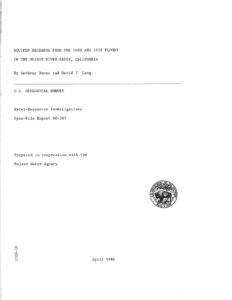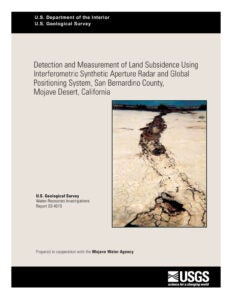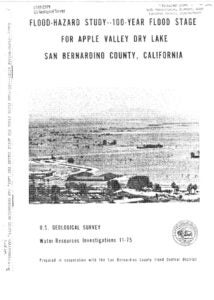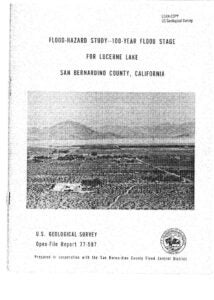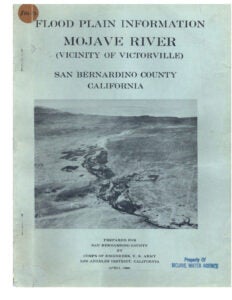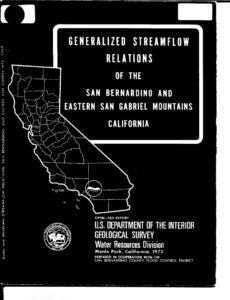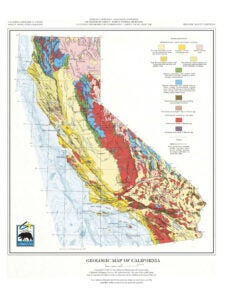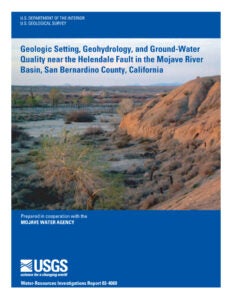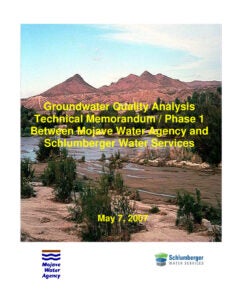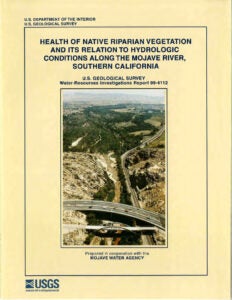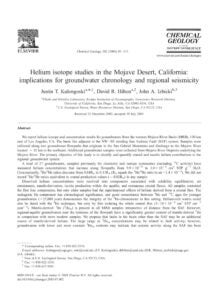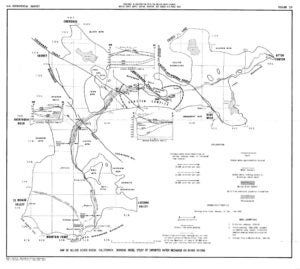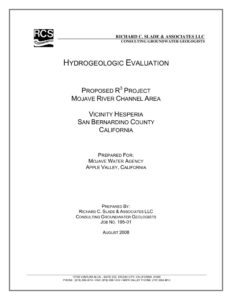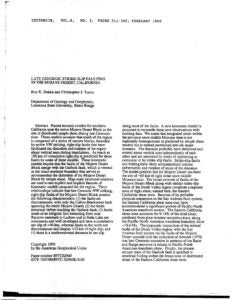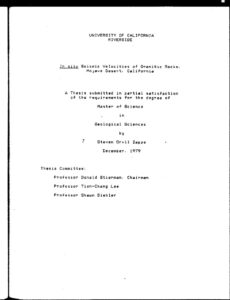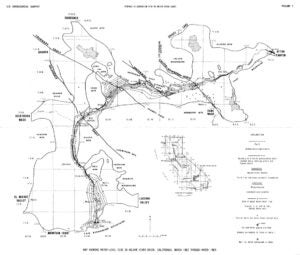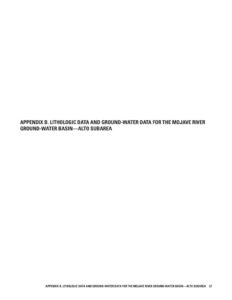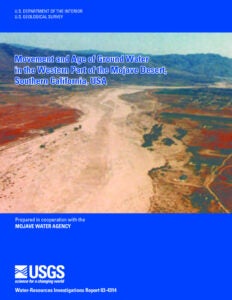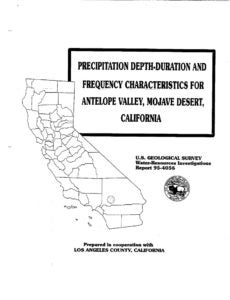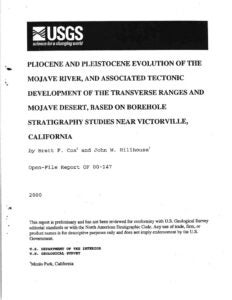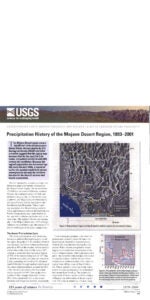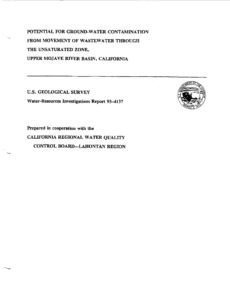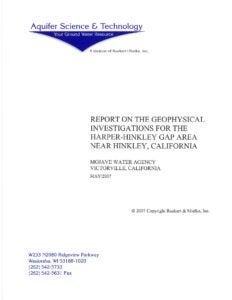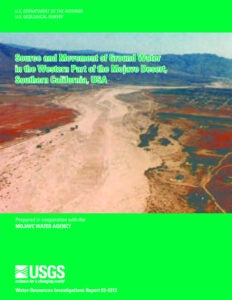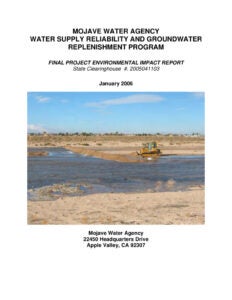Document Library
Documents
Bulletin No. 84 Mojave River Ground Water Basins Investigations, DWR

Aquifer Recharge From the 1969 and 1978 Floods in the Mojave River Basin, California

Changes in Riparian Vegetation in the Southwestern United States: Historical Changes Along the Mojave River, California

Concentrations for Total Dissolved Solids, Arsenic, Boron, Fluoride, and Nitrite-Nitrate for Wells Sampled in the Mojave Water Agency Management Area, California, 1991-1997

Detection and Measurement of Land Subsidence Using Interferometric Synthetic Aperture Radar and Global Positioning System, San Bernardino County, Mojave Desert, California

Flood-Hazard Study — 100-Year Flood Stage for Apple Valley Dry Lake San Bernardino County, California

Flood-Hazard Study — 100-Year Flood Stage for Lucerne Lake San Bernardino County, California

Evapotranspiration Water Use Analysis of Saltcedar and Other Vegetation in the Mojave River Floodplain, 2007 and 2010

Flood Plain Information Mojave River (Vicinity of Victorville) San Bernardino County, California

Generalized Streamflow Relations of the San Bernardino and Eastern San Gabriel Mountains, California

Geologic Map of California

Geologic Setting, Geohydrology and Ground-Water Quality near the Helendale Fault in the Mojave River Basin, San Bernardino County, California

Groundwater Quality Analysis Technical Memorandum/Phase 1 Between Mojave Water Agency and Schlumberger Water Services

Health of Native Riparian Vegetation and its Relation to Hydrologic Conditions along the Mojave River, Southern California

Helium Isotope Studies in the Mojave Desert, California: Implications for Groundwater Chronology and Regional Seismicity

Geologic Map and Borehole Stratigraphy of Hinkley Valley and Vicinity, San Bernardino County, California

Hydrologic Analysis of Mojave River Basin, California, Using Electric Analog Model

Hydrogeologic Evaluation Proposed R3 Project Mojave River Channel Area Vicinity Hesperia San Bernardino County, California

Late Cenozoic Strike-Slip Faulting in the Mojave Desert, California

In Situ Seismic Velocities of Granitic Rocks, Mojave Desert, California

Hydrogeologic Investigation of Camp Cady Wildlife Area CDFG

Mojave River Basin Ground-Water Recharge with Particular Reference to the California Floods of January and February 1969

Lithologic and Ground-Water Data for Monitoring Sites in the Mojave River and Morongo Ground-Water Basins, San Bernardino County, California, 1992-98

Mojave Water Agency Water Supply Reliability and Groundwater Replenishment Program Final Project Environmental Impact Report

Mojave Salt and Nutrient Management Plan Final, Volumes I and II (zipped)

Movement and Age of Ground Water in the Western Part of the Mojave Desert, Southern California, USA

Precipitation Depth-Duration and Characteristics for Antelope Valley, Mojave Desert, California

Pliocene and Pleistocene Evolution of the Mojave River, and Associated Tectonic Development of the Transverse Ranges and Mojave Desert, Based on Borehole Stratigraphy Studies Near Victorville, CA

Precipitation History of the Mojave Desert Region, 1893-2001

Potential for Ground-Water Contamination from Movement of Wastewater through the Unsaturated Zone, Upper Mojave River Basin, California

Report on the Geophysical Investigations for the Harper-Hinkley Gap Area Near Hinkley, California

Riparian Vegetation and Its Water Use During 1995 Along the Mojave River, Southern California

Simulation of Water-Management Alternatives in the Mojave River Ground-Water Basin, California

Source and Movement of Ground Water in the Western Part of the Mojave Desert, Southern California, USA

Report on the Utilization of Mojave River for Irrigation in Victor Valley, California

The Mohave Desert Region, California A Geographic, Geologic, and Hydrologic Reconnaissance

Technical Study to Evaluate a Potential Long-Term Water Management Program Between Mojave Water Agency and Metropolitan Water District

Some Desert Watering Places in Southeastern California and Southwestern Nevada

Water Supply in the Mojave River Ground-Water Basin, 1931-99, and the Benefits of Artificial Recharge

Water Levels and Artesian Pressure in Observation Wells in the United States in 1939

 Bulletin No. 84 Mojave River Ground Water Basins Investigations, DWR
Bulletin No. 84 Mojave River Ground Water Basins Investigations, DWR 